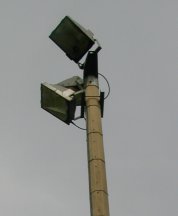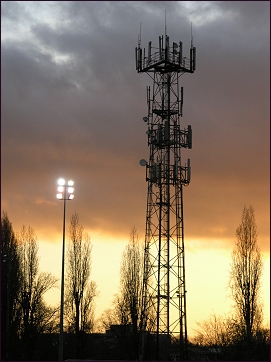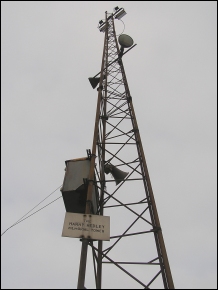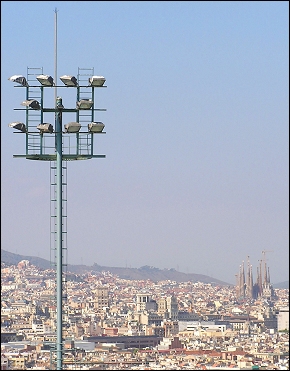|
 In October 1950, following a summer tour of Brazil, Southampton pioneered a floodlit exhibition match against neighbours Bournemouth. Around 10,000 spectators were curious enough to attend, although the free admission probably helped lure them along to the Dell. Although fog rendered the experiment something of a disaster, the precedent had been set and by 1955 Wembley Stadium had its own floodlights, inaugurated with a match between London and Frankfurt in the Inter-Cities Fairs Cup. In October 1950, following a summer tour of Brazil, Southampton pioneered a floodlit exhibition match against neighbours Bournemouth. Around 10,000 spectators were curious enough to attend, although the free admission probably helped lure them along to the Dell. Although fog rendered the experiment something of a disaster, the precedent had been set and by 1955 Wembley Stadium had its own floodlights, inaugurated with a match between London and Frankfurt in the Inter-Cities Fairs Cup.
In the subsequent fifty years or so, floodlights have become part and parcel of the professional game in the UK; and often the barrier that has prevented Non League clubs from rising further up the pyramid. Powerful floodlights are essential for televised evening games; have been blamed for footballing gaffes � usually goalkeeping errors � and implicated in gambling scandals. There is also the safety element: have you ever tried to get out of a ground after the lights have been turned off � or failed?
The measure of illuminance is lumens per square metre, commonly abbreviated to �lux�. The higher the illuminance, the higher is the ability of the eye to distinguish details, small contrasts and colour hues. At County level the minimum lux requirements may be a relatively modest 120 lux, whereas the requirements at international level can be almost ten times that. The 731 lamps at the Stade de France for example, emit a staggering 1,600 lux. To put this into perspective, the sun generates illuminance on the Earth�s surface from 104-105 lux, depending on cloudiness.
Groundhoppers, or first-time visitors to an unfamiliar ground will know only too well the value of floodlights as a navigational aid. �Look for the floodlights� is often the best directional advice that one can give. The glimpse of floodlight pylons on the horizon is usually sufficient to trigger my inbuilt �homing� device. Stepping off a bus on Crete the first thing I spied were the lights of the local football stadium � and off I went, with my family trailing in my wake. Someone once told me that I must have been a moth in a former life, and I have ended up on a railway siding on at least one occasion!
Floodlights do however, divide communities, with �light pollution� a major concern for smaller clubs and local residents. Planning and lighting restrictions therefore play a major role in the game at the lower levels of the pyramid. Apart from anything else, an inability to play evening games has a direct influence on the size of a competition or league and, as mentioned above, restricts a club�s potential for further progression. Floodlights for example, are required for entry into the FA Cup, FA Trophy, and FA Vase.
If I�m honest though, even I have to admit that at Non League level at least, floodlights on the whole are fairly dull (both in interest and lux), with the older more imposing traditional varieties (Weymouth for example), gradually being replaced by modern lights mounted on spindly pylons. Whilst they may be better and more cost-effective at illuminating the action below, they hardly set the pulse racing as one approaches the ground. There are exceptions however: the lights at Stamford�s Worthorpe Road ground for example (pictured above), which are mounted on sandstone pillars in order to blend in with the local environment � and comply with local building regulations. Often the more interesting floodlights are those that make use of existing structures at, or adjacent to the ground, such as electrical pylons or telecommunications masts.
Most casual visitors only notice the floodlights when they are ineffectual or fail to work at all � a bit like referees really. However, next time you visit a ground (preferably when it�s daytime and the lights aren�t on) have a look up. You may be surprised, if only to see some amazing public address systems!.
|


 In October 1950, following a summer tour of Brazil, Southampton pioneered a floodlit exhibition match against neighbours Bournemouth. Around 10,000 spectators were curious enough to attend, although the free admission probably helped lure them along to the Dell. Although fog rendered the experiment something of a disaster, the precedent had been set and by 1955 Wembley Stadium had its own floodlights, inaugurated with a match between London and Frankfurt in the Inter-Cities Fairs Cup.
In October 1950, following a summer tour of Brazil, Southampton pioneered a floodlit exhibition match against neighbours Bournemouth. Around 10,000 spectators were curious enough to attend, although the free admission probably helped lure them along to the Dell. Although fog rendered the experiment something of a disaster, the precedent had been set and by 1955 Wembley Stadium had its own floodlights, inaugurated with a match between London and Frankfurt in the Inter-Cities Fairs Cup.

